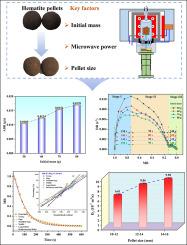Microwave drying characteristics and kinetics of hematite pellets
IF 4.5
2区 工程技术
Q2 ENGINEERING, CHEMICAL
引用次数: 0
Abstract
Microwave drying characteristics and kinetics of hematite pellets were investigated based on evaluation of the effects of initial mass, microwave power and pellet size during the drying process. The results showed the average drying rate increased with initial mass from 50 g to 80 g and microwave power from 600 W to 1000 W. However, it decreased with increasing pellet size from 10–12 mm to 14–16 mm. The process was successively controlled by external diffusion, internal diffusion, and chemical reaction. The Verma model was the most suitable kinetic model for describing the process. The effective diffusion coefficient of moisture ranged from 6.61 × 10−7 m2/s to 9.98 × 10−7 m2/s. The activation energy for the microwave drying process was only 2.83 W/g.

赤铁矿球团的微波干燥特性和动力学
根据对干燥过程中初始质量、微波功率和球团尺寸影响的评估,研究了赤铁矿球团的微波干燥特性和动力学。结果表明,随着初始质量从 50 克增加到 80 克,微波功率从 600 瓦增加到 1000 瓦,平均干燥速率增加。这一过程先后受到外部扩散、内部扩散和化学反应的控制。Verma 模型是描述这一过程最合适的动力学模型。水分的有效扩散系数从 6.61 × 10-7 m2/s 到 9.98 × 10-7 m2/s 不等。微波干燥过程的活化能仅为 2.83 W/g。
本文章由计算机程序翻译,如有差异,请以英文原文为准。
求助全文
约1分钟内获得全文
求助全文
来源期刊

Powder Technology
工程技术-工程:化工
CiteScore
9.90
自引率
15.40%
发文量
1047
审稿时长
46 days
期刊介绍:
Powder Technology is an International Journal on the Science and Technology of Wet and Dry Particulate Systems. Powder Technology publishes papers on all aspects of the formation of particles and their characterisation and on the study of systems containing particulate solids. No limitation is imposed on the size of the particles, which may range from nanometre scale, as in pigments or aerosols, to that of mined or quarried materials. The following list of topics is not intended to be comprehensive, but rather to indicate typical subjects which fall within the scope of the journal's interests:
Formation and synthesis of particles by precipitation and other methods.
Modification of particles by agglomeration, coating, comminution and attrition.
Characterisation of the size, shape, surface area, pore structure and strength of particles and agglomerates (including the origins and effects of inter particle forces).
Packing, failure, flow and permeability of assemblies of particles.
Particle-particle interactions and suspension rheology.
Handling and processing operations such as slurry flow, fluidization, pneumatic conveying.
Interactions between particles and their environment, including delivery of particulate products to the body.
Applications of particle technology in production of pharmaceuticals, chemicals, foods, pigments, structural, and functional materials and in environmental and energy related matters.
For materials-oriented contributions we are looking for articles revealing the effect of particle/powder characteristics (size, morphology and composition, in that order) on material performance or functionality and, ideally, comparison to any industrial standard.
 求助内容:
求助内容: 应助结果提醒方式:
应助结果提醒方式:


